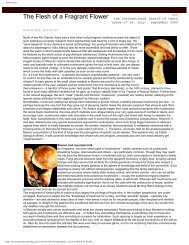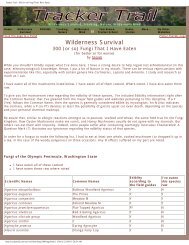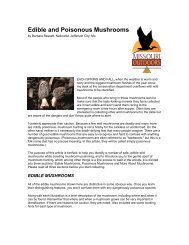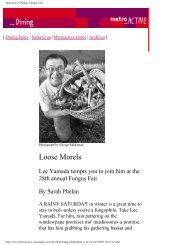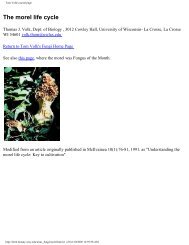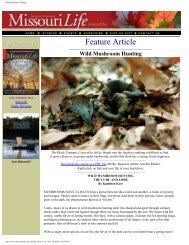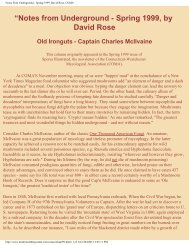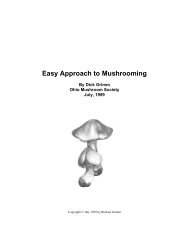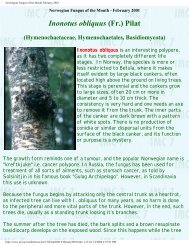COX and XO inhibitors - ResearchGate
COX and XO inhibitors - ResearchGate
COX and XO inhibitors - ResearchGate
Create successful ePaper yourself
Turn your PDF publications into a flip-book with our unique Google optimized e-Paper software.
PAPER<br />
www.rsc.org/obc | Organic & Biomolecular Chemistry<br />
Inotilone <strong>and</strong> related phenylpropanoid polyketides from Inonotus sp.<br />
<strong>and</strong> their identification as potent <strong>COX</strong> <strong>and</strong> <strong>XO</strong> <strong>inhibitors</strong><br />
Hilaire V. Kemami Wangun, a Albert Härtl, a Trinh Tam Kiet b <strong>and</strong> Christian Hertweck* a,c<br />
Received 28th March 2006, Accepted 9th May 2006<br />
First published as an Advance Article on the web 24th May 2006<br />
DOI: 10.1039/b604505g<br />
By bioassay-guided isolation, phenylpropanoid-derived polyketides, including an unusual<br />
5-methyl-3(2H)-furanone derivative (inotilone) with potent cyclooxygenase (<strong>COX</strong>) <strong>and</strong> xanthone<br />
oxidase (<strong>XO</strong>) inhibitory activities were obtained from the fruiting body of the mushroom Inonotus sp.<br />
Introduction<br />
Arthritis is a general term for severe inflammatory processes<br />
in joints or joint tissue. Nonsteroidal anti-inflammatory drugs<br />
(NSAIDs), such as diclofenac <strong>and</strong> indomethacin, have emerged<br />
as the most commonly used anti-inflammatory agents for the<br />
therapy of rheumatoid arthritis. 1 Many of these drugs target<br />
cyclooxygenases (<strong>COX</strong>), which catalyze the first two steps in the<br />
biosynthesis of the prostagl<strong>and</strong>ins from the substrate arachidonic<br />
acid. 2,3 In this context, the selective inhibition of enzyme subtypes,<br />
<strong>COX</strong>-1 <strong>and</strong> <strong>COX</strong>-2, has become an important goal. 4 In contrast<br />
to rheumatoid arthritis, gouty arthritis is mediated by the crystallisation<br />
of uric acid (UA) in the joints. 5,6 Gout can be treated<br />
with drugs that either increase the urinary excretion of UA, or with<br />
xanthine oxidase (<strong>XO</strong>) <strong>inhibitors</strong> that block the terminal step of<br />
UA biosynthesis. 7,8 The purine analogue allopurinol is currently<br />
the only <strong>XO</strong> inhibitor in clinical use. Unfortunately, it seems to be<br />
associated with an infrequent but severe hypersensitivity. 9 Thus,<br />
the search for new potent <strong>inhibitors</strong> of these enzymes, which<br />
could be useful as lead structures for new anti-inflammatory <strong>and</strong><br />
anti-arthritic therapeutics, plays a pivotal role. Here we report<br />
on the isolation, structural elucidation <strong>and</strong> biological evaluation<br />
of natural anti-inflammatory <strong>COX</strong> <strong>and</strong> <strong>XO</strong> <strong>inhibitors</strong> from the<br />
mushroom Inonotus sp.<br />
Results <strong>and</strong> discussion<br />
Extracts from the fruiting body Inonotus sp. exhibited significant<br />
inhibitory activities against key enzymes involved in inflammatory<br />
processes: 3a-HSD, <strong>COX</strong> <strong>and</strong> xanthine oxidase. Bioassay-guided<br />
separation of the combined crude ethanolic <strong>and</strong> CHCl 3 /MeOH<br />
extracts of the fruiting body using open column <strong>and</strong> preparative<br />
HPLC yielded several phenolic compounds 11 (4 mg), 9 (20 mg),<br />
5 (4 mg) together with the known compounds 4 (500 mg) <strong>and</strong> 7 (6<br />
mg) (Scheme 1).<br />
a<br />
Dept. Biomolecular Chemistry, Leibniz-Institute for Natural Products<br />
Research <strong>and</strong> Infection Biology, Beutenbergstr. 11a, 07745, Jena, Germany.<br />
E-mail: christian.hertweck@hki-jena.de; Fax: INT+3641-656705;<br />
Tel: INT+3641-656700<br />
b<br />
Centre of Biotechnology, Vietnam National University, 144 Xuan Thuy<br />
Street, Hanoi, Vietnam<br />
c<br />
Friedrich-Schiller-University, Jena<br />
Scheme 1 Structures of Inonotus sp. metabolites <strong>and</strong> model for their<br />
biosynthesis. Key HMBC <strong>and</strong> NOESY correlations of 11.<br />
The main product from Inonotus sp. was identified as the known<br />
metabolite hispidin (4) by comparison of MS, IR <strong>and</strong> NMR data. 10<br />
In addition to 4, another compound 5 with the same molecular<br />
formula (C 13 H 10 O 5 ) was isolated. Also the 1 H NMR spectrum of<br />
5 showed signals similar to those of 4. 10 However, the 13 CNMR<br />
spectrum, which showed a signal for a conjugated carbonyl at<br />
d 179.1, clearly established 5 as the tautomeric c-pyrone (isohispidin).<br />
This journal is © The Royal Society of Chemistry 2006 Org. Biomol. Chem., 2006, 4, 2545–2548 | 2545
Table 1 Inhibitory activities of 4, 5, 7, 9,<strong>and</strong>11 against 3-aHSD, <strong>COX</strong>-1,<br />
The molecular formula of the second main product (9) was<br />
have been reported from Phellinus igniarius. 11 spectrometer at 300.133 MHz for 1 H <strong>and</strong> 75.475 MHz for 13 C<br />
determined as C 14 H 14 O 6 based on HR-EIMS <strong>and</strong> its 13 CNMR<br />
spectrum. Similar to 4 <strong>and</strong> 5, the 1 H-NMR spectrum showed<br />
signals attributable to the ABX spin coupling system of a<br />
<strong>COX</strong>-2, <strong>and</strong> <strong>XO</strong><br />
IC 50 /lM<br />
trisubstituted phenyl moiety at d 6.77 (1H, d, J = 8.1 Hz, H- Compound 3a-HSD <strong>COX</strong>-1 <strong>COX</strong>-2 <strong>COX</strong>-2/<strong>COX</strong>-1 <strong>XO</strong><br />
12), d 7.02 (1H, dd, J = 8.2, 1.8 Hz, H-13), d 7.07 (1H, d, J =<br />
4 8.1 0.01 8 × 10 −4 0.08 4.4<br />
1.8 Hz H-9), a trans disubstituted double bond at d 7.45 (1H, d, 5 12.1 0.05 0.13 2.6 13.8<br />
J = 15.8 Hz, H-7) <strong>and</strong> d 6.50 (1H, d, J = 15.8 Hz, H-6), <strong>and</strong> 7 8.9 0.03 0.01 0.3 10.1<br />
two exchangeable phenolic hydroxyl protons at d 9.15 <strong>and</strong> 9.65. In 9 16.1 0.46 0.21 0.4 7.1<br />
11 50.4 0.36 0.03 0.08 9.1<br />
addition, a chelated proton at d 15.20 was detected. Analyses of<br />
Indomethacin 15.4 0.10 6.00 60 n.a.<br />
13<br />
C, DEPT 135 <strong>and</strong> HMQC NMR spectra of 9 showed 14 carbon Allopurinol n.a. n.a. n.a. n.a. 4.4<br />
signals including six sp 2 methines, four quaternary sp 2 carbons<br />
(three of which are oxygenated), one methylene carbon at d 45.6,<br />
The structures of compounds 5, 9 <strong>and</strong> 11, as well as the isolation<br />
a methoxy carbon at d 51.8, a carbonyl carbon at d 191.8, <strong>and</strong> a<br />
of the known 4 <strong>and</strong> 7 suggest that all metabolites share the same<br />
carboxyl carbon at d 167.9. HMBC NMR spectra proved to be<br />
biosynthetic origin. All compounds represent linear or cyclized<br />
very helpful in defining their connectivities. The correlation of the<br />
polyketides derived from caffeyl-CoA (1). While 7 appears to<br />
H-9 (d 7.07) with C-7 (d 141.0), C-8 (d 126.2), C-10 (d 145.6), <strong>and</strong><br />
be a shunt product resulting from a premature release from the<br />
C-11 (d 148.4), the correlation of H-12 (d 6.77) with H-8, H-10,<br />
polyketide synthase, 4, 5, 9 <strong>and</strong> 11 are the result of two rounds<br />
H-11, <strong>and</strong> H-13 <strong>and</strong> the correlation of H-13 (d 7.02) with C-7, C-8,<br />
of elongation. The structurally unusual 11 could be the product<br />
C-9, C-11 <strong>and</strong> C-12, revealed an ortho substitution of the phenolic<br />
of a decarboxylation-radical ring closure sequence via the known<br />
hydroxyl protons. Other important information was obtained from<br />
metabolite hispolon 10. 12 A related sequence could be involved<br />
the observed correlation of the methylene protons (H-2) with C-1<br />
in the formation of the tri- <strong>and</strong> tetrahydroxyaurone aglycones of<br />
(d 167.9), C-3 (d 191.8) <strong>and</strong> C-4 (d 100.3). Structural deductions<br />
sulfurein <strong>and</strong> cernuosides. 13,14<br />
from NMR data were supported by the IR spectrum of 9, which<br />
All compounds were evaluated for their inhibitory activities in<br />
showed absorption b<strong>and</strong>s for hydroxyl groups at 3183 cm −1 ,a<br />
conjugated carbonyl (1632 cm −1 ) a carboxyl group at 1733 cm −1 ,<br />
hydroxysteroid dehydrogenase (3a-HSD), <strong>COX</strong>-1, <strong>COX</strong>-2 <strong>and</strong> <strong>XO</strong><br />
enzyme assays according to previously documented procedures.<br />
<strong>and</strong> aromatic rings (1567, 1513 <strong>and</strong> 1435 cm −1 ). Consequently, 9<br />
Their inhibitory potencies, expressed as IC 50 values, are shown<br />
represents the methyl ester of the open chain derivative of 4 or 5,<br />
in Table 1 <strong>and</strong> are compared with those of the references,<br />
<strong>and</strong> was named inonotic acid methyl ester.<br />
indomethacin <strong>and</strong> allopurinol. The results in the present study<br />
The molecular formula of compound 11 was determined as<br />
demonstrated that the phenolic compounds exhibit strong <strong>COX</strong><br />
C 12 H 10 O 4 based on HR-EIMS <strong>and</strong> 13 C NMR data. Similar to 4, 5<br />
inhibitory effects with a prevalence for <strong>COX</strong>-2 in the case of<br />
<strong>and</strong> 9,the 1 H NMR spectrum of 11 showed signals attributable to<br />
the compounds 4, 7, 9 <strong>and</strong> 11. It should be highlighted that<br />
the ABX spin coupling system of a trisubstituted phenyl moiety.<br />
hispidin (4) <strong>and</strong> the novel inotilone (11) selectively inhibit <strong>COX</strong>-<br />
Two olefinic protons at d 6.49 (1H, s, H-6), d 5.82 (1H, d, J =<br />
2 at concentrations as low as those of the marketed selective<br />
0.6 Hz, H-4) <strong>and</strong> a methyl group at d 2.39 (3H, s, H-13) were also<br />
<strong>inhibitors</strong> meloxicam <strong>and</strong> nimesulide. 3 In all cases, except for<br />
observed. Two proton signals were attributable to the phenolic<br />
compound 11, strong 3a-HSD inhibitory effects were noted, as<br />
exchangeable hydroxyl protons. The 13 C NMR <strong>and</strong> DEPT 135<br />
well as moderate inhibitory effects toward <strong>XO</strong>, except hispidin<br />
spectra of 11 showed 11 sp 2 carbon signals including five methines<br />
(4), which exhibited an inhibitory activity at a level comparable<br />
<strong>and</strong> five quaternary oxygenated carbons including one carbonyl.<br />
with that of the st<strong>and</strong>ard allopurinol. As far as the tautomeric<br />
The occurrence of the carbonyl moiety was confirmed by the 13 C<br />
compounds 4 <strong>and</strong> 5 are concerned, it seems that the a-pyrone is<br />
spectrum, which showed one signal at d 186.6. The protonated<br />
more active than the c-pyrone.<br />
carbons <strong>and</strong> their corresponding protons <strong>and</strong> the full connection<br />
In summary, we have isolated <strong>and</strong> characterized three new<br />
of compound 11 were established using HMQC <strong>and</strong> HMBC<br />
phenylpropanoid polyketides with potent <strong>COX</strong> <strong>and</strong> <strong>XO</strong> inhibitory<br />
experiments, respectively. The correlation of the methyl proton<br />
activities from the mushroom Inonotus sp. Apart from their potent<br />
d 2.39 (3H, s, H-13) with C-2 (d 180.4), <strong>and</strong> C-3 (d 105.4),<br />
anti-arthritic activities, these metabolites represent new members<br />
<strong>and</strong> the correlation of the olefinic proton H-3 (d 5.82) with C-<br />
of caffeyl derived polyketides, out of which the structure of<br />
4 (carbonyl moiety) <strong>and</strong> C-5 (d 144.3) unambiguously revealed<br />
inotilone is most notable.<br />
a disubstituted dihydrofuranone moiety. The correlation of the<br />
olefinic proton H-6 (d 6.49) with C-4 (d 186.6), C-5 (d 144.3),<br />
C-7 (d 122.9), C-8 (d 117.9) <strong>and</strong> C-12 (d 124.7) enabled us to<br />
connect the dihydrofuranone moiety with the rest of the molecule.<br />
The configuration of the C-5 double bond was established based<br />
on molecular modeling <strong>and</strong> NOESY, which showed a correlation<br />
between H-6 (d 6.49) <strong>and</strong> H-3 (d 5.82) <strong>and</strong> the correlation between<br />
the protons H-8 (d 7.35) <strong>and</strong> H-12 (d 7.17) with the methyl<br />
protons H-13 (d 2.39). Thus the structure was established as 2-<br />
(3,4-dihydroxybenzylidene)-5-methyfuran-3-one, named inotilone<br />
(11). Only recently, related 5-methyl-3(2H)-furanone metabolites<br />
Experimental<br />
General experimental procedures<br />
IR spectra (film) were recorded on a JASCO FT/IR-4100 spectrometer<br />
equipped with an ATR device. UV spectra were measured<br />
with a Spericord 200 Carl Zeiss spectrometer. High-resolution<br />
electron impact mass spectra (HR-EIMS) were recorded on an<br />
AMD 402 double-focussing mass spectrometer with BE geometry.<br />
NMR spectra were recorded on a Bruker Avance 500 DRX<br />
2546 | Org. Biomol. Chem., 2006, 4, 2545–2548 This journal is © The Royal Society of Chemistry 2006
in DMSO-d6. Chemical shifts are given in ppm relative to TMS<br />
as internal st<strong>and</strong>ard. HSQC <strong>and</strong> NOESY (mixing time 0.7 s)<br />
data were obtained in the phase-sensitive mode TPPI. Column<br />
chromatography was performed using silica gel (60, Merck; 0.063–<br />
0.2 lm) <strong>and</strong> Sephadex LH-20. HPLC was performed using a<br />
Gilson binary gradient HPLC system equipped with a UV detector<br />
(UV/VIS-151)(370 nm) using a preparative reverse phase C 18<br />
(7 lm) column. TLC was carried out with silica gel 60 F 254 plates.<br />
Spots were visualized by spraying with vanilline/H 2 SO 4 followed<br />
by heating. All solvents used were spectral grade or distilled prior<br />
to use.<br />
Strains<br />
The fruiting body of Inonotus sp. was collected in Vietnam.<br />
Its identity was verified by Prof. Trinh Tam Kiet from the<br />
Mycological Research Center, Hanoi State University, Vietnam,<br />
where a specimen was deposited.<br />
Extraction <strong>and</strong> isolation<br />
The fruiting body of Inonotus sp. (25 g dry weight) was cut<br />
into small species, dried <strong>and</strong> crushed. The resulting powder was<br />
extracted three times with ethanol (2 L) <strong>and</strong> chloroform–methanol<br />
(1 : 1) (3 × 2 L, 3 days each). The extracts were subjected to silica<br />
gel chromatography (silica gel 60, Merck, 0.063∼0.1 mm, column<br />
4 × 60 cm), using stepwise CHCl 3 –MeOH (9 : 1, 8 : 2, 1 : 1 v/v)<br />
as eluent. Final purification was achieved by preparative HPLC<br />
(Spherisorb ODS-2 RP 18 ,5lm (Promochem), 250 × 25 mm,<br />
acetonitrile–H 2 O(83:17v/v), at a flow rate of 10 ml min −1 <strong>and</strong><br />
UV detection at 372 nm). Yields: 500 mg of 4, 4 mg of 5, 6 mg of<br />
7, 20mgof9,<strong>and</strong>4mgof11.<br />
iso-Hispidin (5). Was obtained as a red oil by open column<br />
chromatography on Sephadex LH20 using CHCl 3 –MeOH 80 : 20<br />
as eluent. Further purification was done by HPLC using gradient<br />
(water–acetonitrile 95 : 5 to 5 : 95; 30 min) R t = 14 min; UV<br />
(MeOH) k max 248, 361 nm; IR (film) 3059, 1649, 1590, 1494, 1411,<br />
1276, 1202, 1050, 1000 cm −1 ; 1 H NMR (DMSO-d 6 , 300 MHz) data<br />
see Table 2; 13 C NMR (DMSO-d 6 ,75MHz)dataseeTable2;m/z<br />
245 [M − H] − ; HR-EIMS (found [M − H] − ): 245.0464 calcd. for<br />
C 15 H 15 O 6 : 245.0445).<br />
Inonotic acid methyl ester (9). Was obtained as a yellow oil by<br />
open column chromatography on Sephadex LH 20 using CHCl 3 –<br />
MeOH (v/v = 90 : 10) as eluent. Further purification was achieved<br />
by HPLC using a water–acetonitrile gradient (95 : 5 to 5 : 95;<br />
30 min) R t = 20.5 min; UV (MeOH) k max 261, 380 nm; IR (film)<br />
3094, 1733, 1632, 1567, 1513, 1435, 1282, 1022, 974 cm −1 ; 1 HNMR<br />
(DMSO-d 6 , 300 MHz) data see Table 2; 13 C NMR (DMSO-d 6 ,75<br />
MHz) data see Table 2; m/z 277 [M − H] − ; HR-EIMS (found<br />
[M − H] − ): 277.0682 calcd. for C 14 H 13 O 6 : 277.0707).<br />
Inotilone (11). Was obtained as a yellow oil by open column<br />
chromatography on Sephadex LH 20 using CHCl 3 –MeOH (v/v =<br />
85 : 15) as eluent. Further purification was achieved by HPLC<br />
using a water–acetonitrile gradient (95 : 5 to 5 : 95; 30 min); R t =<br />
16 min; UV (MeOH) k max 264, 312, 378 nm; IR (film) 3184, 1682,<br />
1588, 1435, 1287, 1014, 951 cm −1 ; 1 HNMR (DMSO-d 6 , 300 MHz)<br />
data see Table 2; 13 C NMR (DMSO-d 6 ,75MHz)dataseeTable2;<br />
m/z 217 [M − H] − ; HR-EIMS (found [M − H] − ): 217.0495, calcd.<br />
for C 12 H 9 O 4 : 217.0495).<br />
Biological assays<br />
The 3a-hydroxy steroid dehydrogenase assay (3-aHSD) was measured<br />
spectrophotometrically, <strong>and</strong> conducted according to the<br />
method described by Penning. 15 The inhibitory activities of the<br />
test compounds are indicated in terms of IC 50 . Indomethacin was<br />
used as reference.<br />
The peroxidative activity of cyclooxygenases I <strong>and</strong> II was<br />
measured using luminol as a specific chemiluminescent substrate<br />
according to the method described by Forghani et al. 16 The<br />
inhibitory activities of the test compounds are given in terms of<br />
IC 50 . Indomethacin was used as reference.<br />
The xanthine oxidase activity was measured using lucigenin as<br />
the chemiluminescence substrate, <strong>and</strong> conducted according to the<br />
method described by Pierce et al. 17 The inhibitory activities of the<br />
test compounds are indicated in terms of IC 50 . Allopurinol was<br />
used as the reference.<br />
Table 2<br />
1 H<strong>and</strong> 13 CNMRdata a for compounds 5, 9,<strong>and</strong>11<br />
5 9 11<br />
N ◦ d 1 H(J/Hz) d 13 C d 1 H(J/Hz) d 13 C d 1 H(J/Hz) d 13 C<br />
1 167.9<br />
2 165.4 3.55 s 45.6 180.4<br />
3 4.42 d (1.2) 86.5 191.8 5.82 q 105.5<br />
4 179.1 5.91 s 100.3 186.6<br />
5 5.59 d (1.2) 109.0 178.3 144.3<br />
6 156.1 6.50 d (15.8) 118.6 6.49 s 111.9<br />
7 6.12 d (15.8) 118.5 7.45 d (15.8) 141.0 122.9<br />
8 6.87 d (15.8) 130.8 126.2 7.35 d (2.0) 117.9<br />
9 127.4 7.07 d (1.8) 114.7 145.4<br />
10 6.94 d (1.5) 113.5 145.6 148.1<br />
11 145.6 148.4 6.80 d (8.2) 115.9<br />
12 146.5 6.77 d (8.1) 115.7 7.17 dd (8.2, 2.0) 124.7<br />
13 6.70 d (8.1) 115.7 7.02 dd (8.1,1.8) 121.5 2.39 s 15.67<br />
14 6.82 dd (8.1,1.5) 119.2<br />
1 ′ 3.65 s 51.8<br />
a<br />
Recorded in DMSO-d6.<br />
This journal is © The Royal Society of Chemistry 2006 Org. Biomol. Chem., 2006, 4, 2545–2548 | 2547
Acknowledgements<br />
This project has been financially supported by the European<br />
Community in the FP5 EUKETIDES programme. We thank<br />
Mrs Schwinger <strong>and</strong> Mrs Röhrig for their excellent assistance in<br />
isolation <strong>and</strong> assays.<br />
References<br />
1 S. I. Rennard, Proc. Am. Thorac. Soc., 2004, 1, 282.<br />
2 J. R. Vane <strong>and</strong> R. M. Botting, Inflammation Res., 1998, 47(Suppl 2),<br />
78.<br />
3 J. R. Vane, Y. S. Bakhle <strong>and</strong> R. M. Botting, Annu. Rev. Pharmacol.<br />
Toxicol., 1998, 38, 97.<br />
4 D. L. Simmons, R. M. Botting <strong>and</strong> T. Hla, Pharmacol. Rev., 2004, 56,<br />
387.<br />
5 N. Dalbeth <strong>and</strong> D. O. Haskard, Rheumatology (Oxford, U. K.), 2005,<br />
44, 1090.<br />
6 H. K. Choi, D. B. Mount <strong>and</strong> A. M. Reginato, Ann. Intern. Med., 2005,<br />
143, 499.<br />
7 G. Rastelli, L. Costantino <strong>and</strong> A. Albasini, J. Am. Chem. Soc., 1997,<br />
119, 3007.<br />
8 S. Ishibuchi, H. Morimoto, T. Oe, T. Ikebe, H. Inoue, A. Fukunari, M.<br />
Kamezawa, I. Yamada <strong>and</strong> Y. Naka, Bioorg. Med. Chem. Lett., 2001,<br />
11, 879.<br />
9 K. R. H<strong>and</strong>e, R. M. Noone <strong>and</strong> W. J. Stone, Am.J.Med., 1984, 76, 47.<br />
10 L. R. Brady <strong>and</strong> R. G. Benedict, J. Pharm. Sci., 1972, 61, 318.<br />
11 S. Mo, S. Wang, G. Zhou, Y. Yang, Y. Li, X. Chen <strong>and</strong> J. Shi, J. Nat.<br />
Prod., 2004, 67, 823.<br />
12 A. A. N. Ali, R. Jansen, H. Pilgrim, K. Liberra <strong>and</strong> U. Lindequist,<br />
Phytochemistry, 1996, 41, 927.<br />
13 M. Shimokoriyama <strong>and</strong> S. Hattori, J. Am. Chem. Soc., 1953, 75, 1900.<br />
14 M. K. Seikel <strong>and</strong> T. A. Geissman, J. Am. Chem. Soc., 1950, 72, 5725.<br />
15 T. M. Penning, J. Pharm. Sci., 1985, 74, 651.<br />
16 F. Forghani, M. Ouellet, S. Keen, M. D. Percival <strong>and</strong> P. Tagari, Anal.<br />
Biochem., 1998, 264, 216.<br />
17 L. A. Pierce, W. O. Tarnow-Mordi <strong>and</strong> I. A. Cree, Int. J. Clin. Lab. Res.,<br />
1995, 25, 93.<br />
2548 | Org. Biomol. Chem., 2006, 4, 2545–2548 This journal is © The Royal Society of Chemistry 2006



